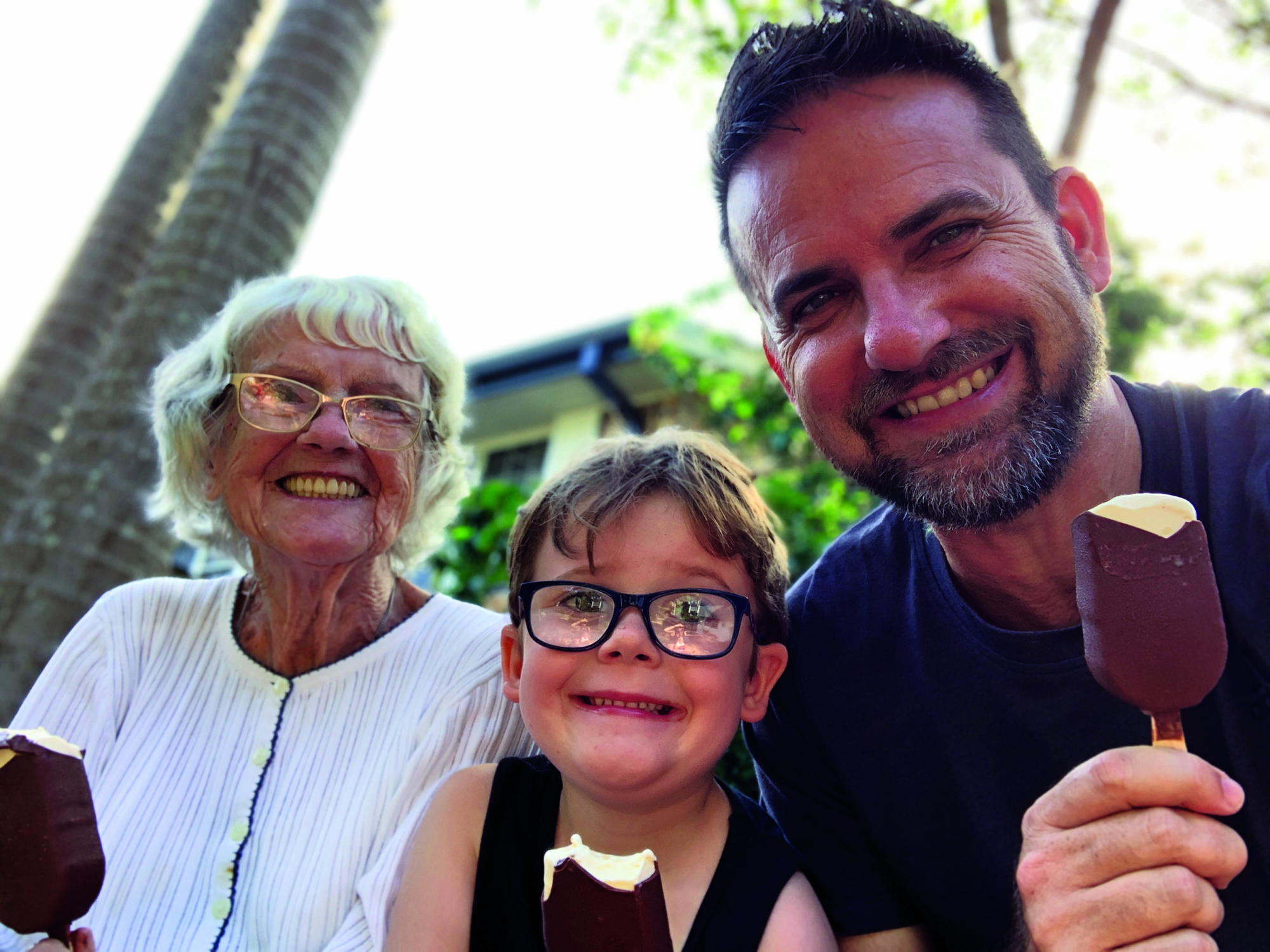Jason is a video director obsessed with making short films about his family. This one’s a little bit longer.
– Epigraph, Everybody’s Oma
There has long been a tension between the private life and autonomy of the documentary subject and the public-facing nature of documentary storytelling. In the case of Everybody’s Oma (Jason van Genderen, 2022), the tension is stretched tight due to the vulnerability of a subject who cannot give consent to her representation on screen.
Everybody’s Oma grew out of a series of Facebook posts shared by filmmaker van Genderen about his family’s experience of caring for his mother, Hendrika (whom they call Oma, the Dutch word for ‘Grandma’). The film’s narrative focus on the performative space of social media highlights how uncertain and negotiable the boundaries between public and private experience have become, while also posing questions about the ethics of negotiating those boundaries on another’s behalf. Nevertheless, whatever conclusion a viewer may reach about the documentary ethics of Everybody’s Oma, the film bears witness to the realities of caring for a loved one with dementia and is brave in its staging of the ethical dilemmas and contradictions at its heart.
Everybody’s Oma has its roots in van Genderen’s passion for the immediacy and flexibility of filming on a smartphone. The iPhone is not only the modus operandi of his production company Treehouse Creative but also a key tool in his ongoing autobiographical practice of documenting and responding to personal experiences and emotional challenges. Having explored homelessness, family separation and urban decay in a series of short films, van Genderen turned his iPhone in the direction of his parents after his father was diagnosed with terminal cancer a little over a decade ago. His short film The Unspoken (2011) is a portrait of van Genderen’s father, Jan, and ‘a story about how it’s important to tell people what you think of them while they’re still around’;[1]John Polson, quoted in Garry Maddox, ‘Tropfest Tears to Flow with Love Letter to Dying Father’, The Sydney Morning Herald, 9 February 2011, <https://www.smh.com.au/entertainment/movies/tropfest-tears-to-flow-with-love-letter-to-dying-father-20110208-1aljs.html>, accessed 12 August 2022. while a subsequent short, Beholder (2019), is a homage to Jan’s creative practice as a drafter and a sculptor. With Everybody’s Oma, the director’s focus moved to Hendrika and her struggle with the degenerative impacts of Alzheimer’s disease and vascular dementia.
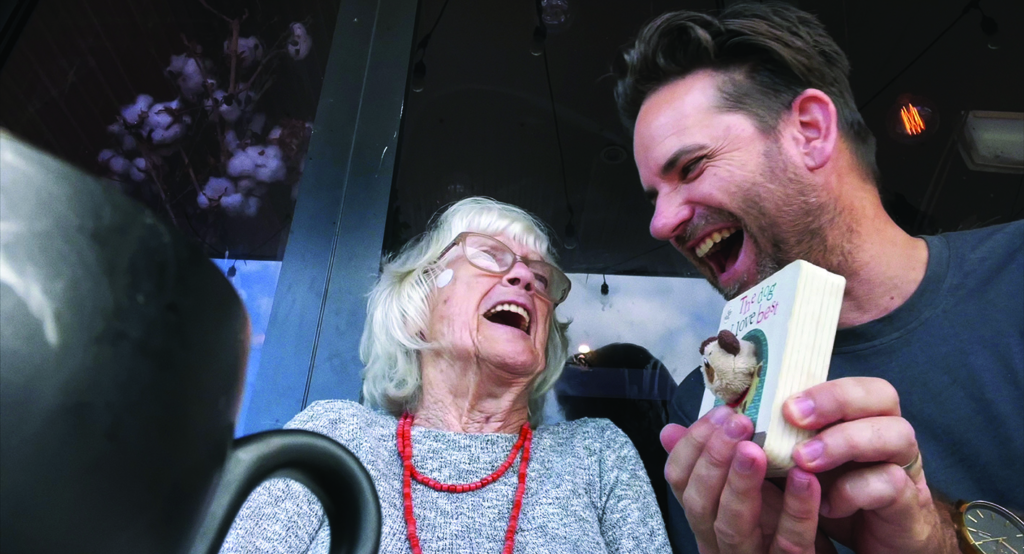
In 2017, some years after Jan’s death, van Genderen and his family moved with Hendrika to a house with an attached granny flat.[2]Brigid Delaney, ‘What Happened After a Grandma with Dementia Went Viral: “I Get the Trolling – I Didn’t Enjoy It”’, The Guardian, 10 August 2022, <https://www.theguardian.com/film/2022/aug/10/what-happened-after-a-grandma-with-dementia-went-viral-i-get-the-trolling-i-didnt-enjoy-it>, accessed 15 August 2022. While Hendrika could no longer cope on her own, the plan was for her to be supported in a safe environment but also have her own space, including a kitchen where she could prepare meals. The documentary begins at a point where her memory loss and failing health are putting a strain on the family as they struggle to care for her and ensure her quality of life. Much of what the viewer sees has been filmed by van Genderen and his wife, Megan, on their phones – clips that, the director observes, ‘became organic video diaries’.[3]Jason van Genderen, ‘Director’s Statement’, Oma’s Applesauce Productions, Everybody’s Oma press kit, 2022, p. 5. In the film’s prologue, van Genderen checks in with his mother about how much she understands about being captured on video to be watched by others. Asking, ‘Why do you think I’m filming?’ he then goes on to explain – both to her and to the wider audience for this content – that it is ‘so that we don’t forget all the beautiful things about you’. There are a number of exchanges of this kind throughout the film, and, while they do not resolve underlying issues of consent, they establish Hendrika’s enjoyment of the moment and the happiness that her son’s attention is giving her.
Van Genderen is an avid user of social media who has crafted an outgoing online persona through posts that intertwine his creative and entrepreneurial endeavours with more personal stories. These stories focus on family, friends and community, and for some time also featured videos of Hendrika’s activities and the family’s efforts to provide her with the support she needed. Some of the posts include the director taking his mother out for a special meal, Hendrika carefully sweeping up fallen leaves in the garden and her small grandson Arty heading upstairs with a bunch of dahlias to join his Oma for dinner. These videos are a testament not only to the love and creative energy the family invested in Hendrika but also to her exceptionally sweet and loving personality.
When the COVID-19 pandemic arrives in 2020, lockdown disrupts Hendrika’s daily routines, including her weekly shopping trip. This disruption inspires van Genderen and his family to replicate a visit to the supermarket in their home. They don’t do things by halves, and the video of Hendrika’s shopping trip is a huge success, both within the multigenerational family unit and, once posted online, as a viral international media sensation.[4]‘Oma Shopping at Home During Isolation’, Facebook video, 27 April 2020, <https://www.facebook.com/omasapplesauce/videos/oma-shopping-at-home-during-isolation/237399264000653/>, accessed 15 August 2022. It garners interest from Good Morning America, The Late Late Show with James Corden and a plethora of Australian media outlets. In the wake of all this interest and enthusiasm, van Genderen sets up a separate Facebook account – ‘Omas Applesauce’ – where he consolidates news about Hendrika and discusses the challenges of living with a parent with Alzheimer’s, and, through doing so, builds an audience and sense of community and connection around the issue. The director has reflected that the video landed at a point in the pandemic when people were struggling to cope with the isolation and disconnection it had wrought, and that they ‘found something they could relate to’ in his family’s story.[5]Jason van Genderen, quoted in Amy Sinclair, ‘Coles Supermarket Social Media Sensation Hendrika “Oma” van Genderen Passes Away at Age 89’, 7news.com.au, updated 6 March 2022, <https://7news.com.au/lifestyle/shopping/coles-supermarket-social-media-sensation-hendrika-oma-van-genderen-passes-away-at-age-89-c-5915565>, accessed 15 August 2022.
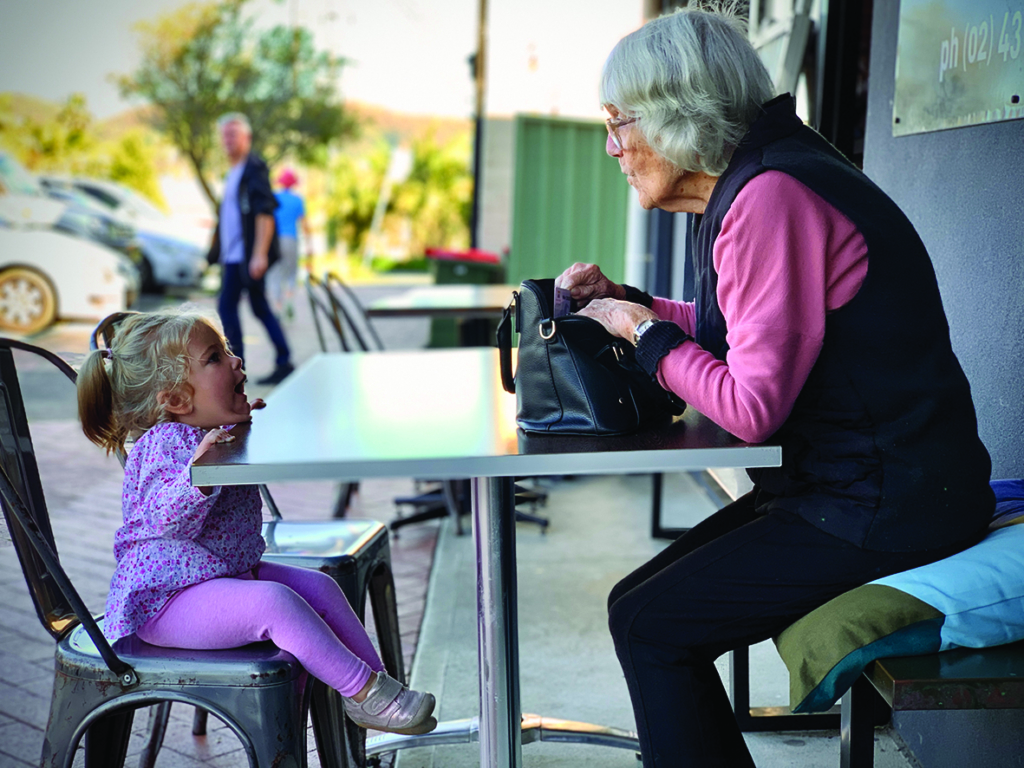
Everybody’s Oma leads the viewer gently into the rocky terrain of what it is like to care for someone with Alzheimer’s and vascular dementia, beginning with a collage of family life in the idyllic setting of the New South Wales Central Coast community of Forresters Beach that establishes Hendrika as a cheery soul with heaps of energy and an ongoing interest in the activities the family cooks up for her. With old age and dementia typically associated with a loss of efficacy and a life lived less fully, the family’s proactive commitment to making life better for Hendrika strikes a positive note that is amplified by the feel-good vibe of the multiple media appearances and countless supportive Facebook comments that greet the shopping video.
The performative, outward-facing positivity generated by the shopping video is interrupted by the lived reality of caring for Hendrika, as seen in a distressing and apparently much more private video of her son and daughter-in-law patching her up after she has sustained a head wound from a fall in her flat. The camera tracks a trail of blood around the room as the family does an at-home triage to decide whether she needs to go to hospital. This is a chilling moment, not just because the charming and very vulnerable Hendrika is injured, but because, in the midst of this distress, someone has thought to set up a camera and film the crisis as it unfolds. As the documentary narrative continues, van Genderen’s determination to keep filming at all costs remains a source of viewer discomfort, but is also a fascinating insight into the filmmaker’s commitment to documenting the experience of caring for his mother.
The art, craft and showmanship that go into this homemade spectacle reveal the Janus gaze that drives van Genderen’s depiction of his mother and her story: he simultaneously faces inwards to his ailing mother and his family and outwards to a wider audience.
The mood lightens when a subsequent well-placed time-lapse video highlights that something special is afoot. A flurry of activity sees the whole family joining together to put together an elaborate Mother’s Day surprise for Hendrika during the ongoing COVID lockdown. Her son escorts her into the family’s candlelit garden, where she is greeted by Arty, who helps her into a chair trimmed with fairy lights and tucks a patchwork quilt over her knees. After van Genderen gives the signal, the inside curtains are opened to reveal that the windows of the house have become a screen for an underwater projection of tropical fish swimming through a cobalt blue seascape; the house has been transformed into a magical realm inspired by the director’s childhood memories of family trips to Sydney Aquarium. The art, craft and showmanship that go into this homemade spectacle reveal the Janus gaze that drives van Genderen’s depiction of his mother and her story: he simultaneously faces inwards to his ailing mother and his family and outwards to a wider audience. At the beginning of the Facebook video marking this special night, he comments to camera: ‘We’re going to create a little experience. We’re going to film it so she can enjoy it on Mother’s Day as many times as she wants, and we can share it with you guys as well.’[6]‘We Turned Oma’s House into an Aquarium for Mothers Day!’, Facebook video, 10 May 2020, <https://www.facebook.com/watch/?v=234827744512794>, accessed 16 August 2022. The video becomes another social media hit, occasioning an offer from SEA LIFE Sydney Aquarium for the family to enjoy an exclusive visit and special dinner, albeit under the watchful gaze of TV cameras from the Nine Network’s Today Extra show.[7]‘Oma at the Aquarium’, YouTube, 25 August 2020, <https://www.youtube.com/watch?v=m84ESPORyRE>, accessed 15 August 2022.
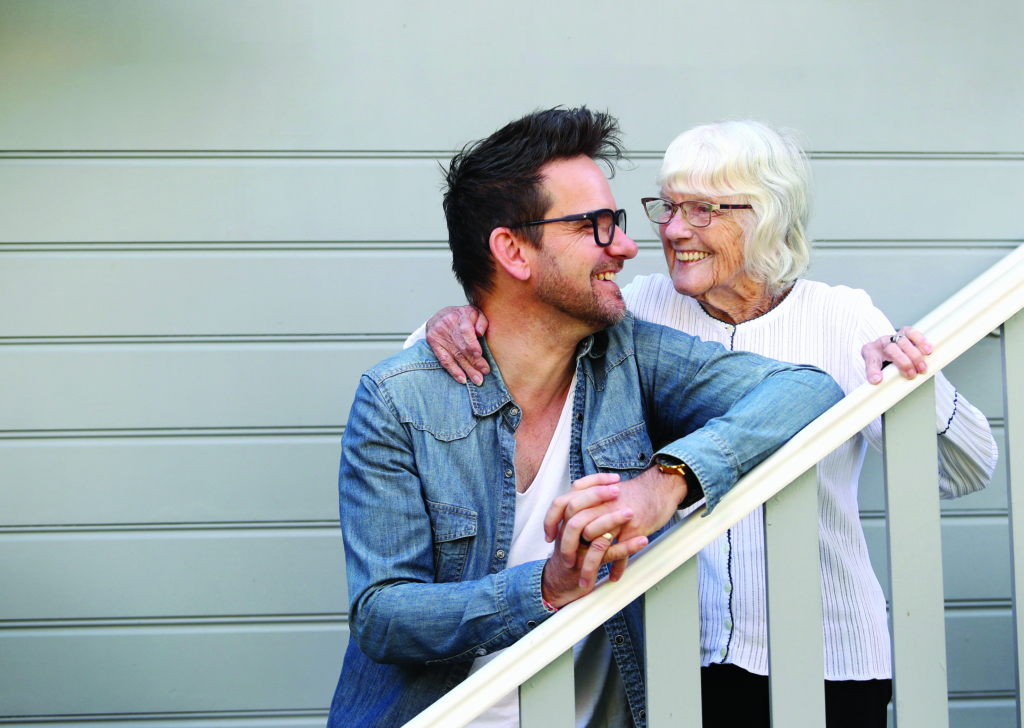
Although van Genderen’s Facebook video of this event includes Hendrika being patched up after a fall the previous day, it presents the actual visit to the aquarium in the same positive vein as the shopping video, while the TV report about the event is unequivocally heartwarming and inspirational. By contrast, this is the point where the documentary pushes back against the feel-good impulse that drove much of the public representation of family life with Hendrika. The behind-the-scenes story of her visit to the aquarium, captured by van Genderen’s unstoppable smartphone camera, includes her falling just as she finishes her TV interview and before she gets a chance to join the family for a delicious dinner surrounded by the magnificent aquarium seascape; this abrupt change of mood is a sobering reminder of Hendrika’s vulnerability and the challenges faced by the family as a whole. As her son and daughter-in-law tend to her with their trusty first-aid kit (which has its own Facebook video![8]‘Our First Aid Bag’, Facebook video, 12 September 2021, <https://www.facebook.com/omasapplesauce/videos/188826459897548>, accessed 16 August 2022.), the two debate what to do next. The implication is that Megan just wants to get out of there, while her husband reasons that they have a two-hour drive ahead of them, Oma and the children need to eat … and they have a commitment to the TV crew. ‘We should just put on a brave face and finish it,’ he says. The contrast between the public story and the private reality is highlighted by an edit that cuts between the story filmed by the TV cameras and the untidy reality recorded on the ever-present smartphone.
In the wake of this change of tone, the film shifts its focus more starkly towards the cracks appearing in the household and the difficulties of caring for someone with dementia. At the end of lockdown, Hendrika re-emerges for her first shopping trip to the supermarket in four months. By this stage, the documentary has wielded enough of its magic for the viewer to be aware of the significance of this supermarket visit and of each item ticked off her list, including her beloved apple sauce. However, the tenderness associated with this trip is juxtaposed with Hendrika expressing her concern to van Genderen that Megan has taken money from her purse, and he and Megan respond with annoyance. That the couple’s exchange takes place while the latter is waxing her legs could be seen as fly-on-the-wall honesty, but, as van Genderen parodies his mother’s accent and Megan expresses frustration at her confusion, Hendrika’s isolation and defencelessness strike at the viewer’s heart.
The story that this documentary is seeking to tell depends on balancing the positive representation of the love that weaves this family together with an unvarnished depiction of the challenges of caring for someone with dementia. As the family reaches a point of crisis in Hendrika’s care, the performative videos drawn from social media give way to grittier fly-on-the-wall video footage, to-camera video diary entries and webcam surveillance of Hendrika’s flat. The scenes depicting the couple’s descent into despair are prefaced by a video in which van Genderen impatiently instructs his mother on her meal routines, which prompted outrage when posted on the Omas Applesauce Facebook page.[9]‘A Little Plate of Patience’, Facebook video, 27 February 2021, <https://www.facebook.com/omasapplesauce/videos/422218282407134>, accessed 16 August 2022. Having so carefully built positive messaging around caring for his mother, van Genderen finds his attempt to communicate the stress of constantly caring for his mother interpreted by many of his followers as evidence of disrespect and neglect, and is met by a barrage of accusatory Facebook comments. These criticisms appear on the screen first as a trickle and then as an unstoppable deluge of negativity, leading to an increasing sense of isolation for the family as they struggle to look after Hendrika and are forced to let go of their commitment to caring for her in the family home.
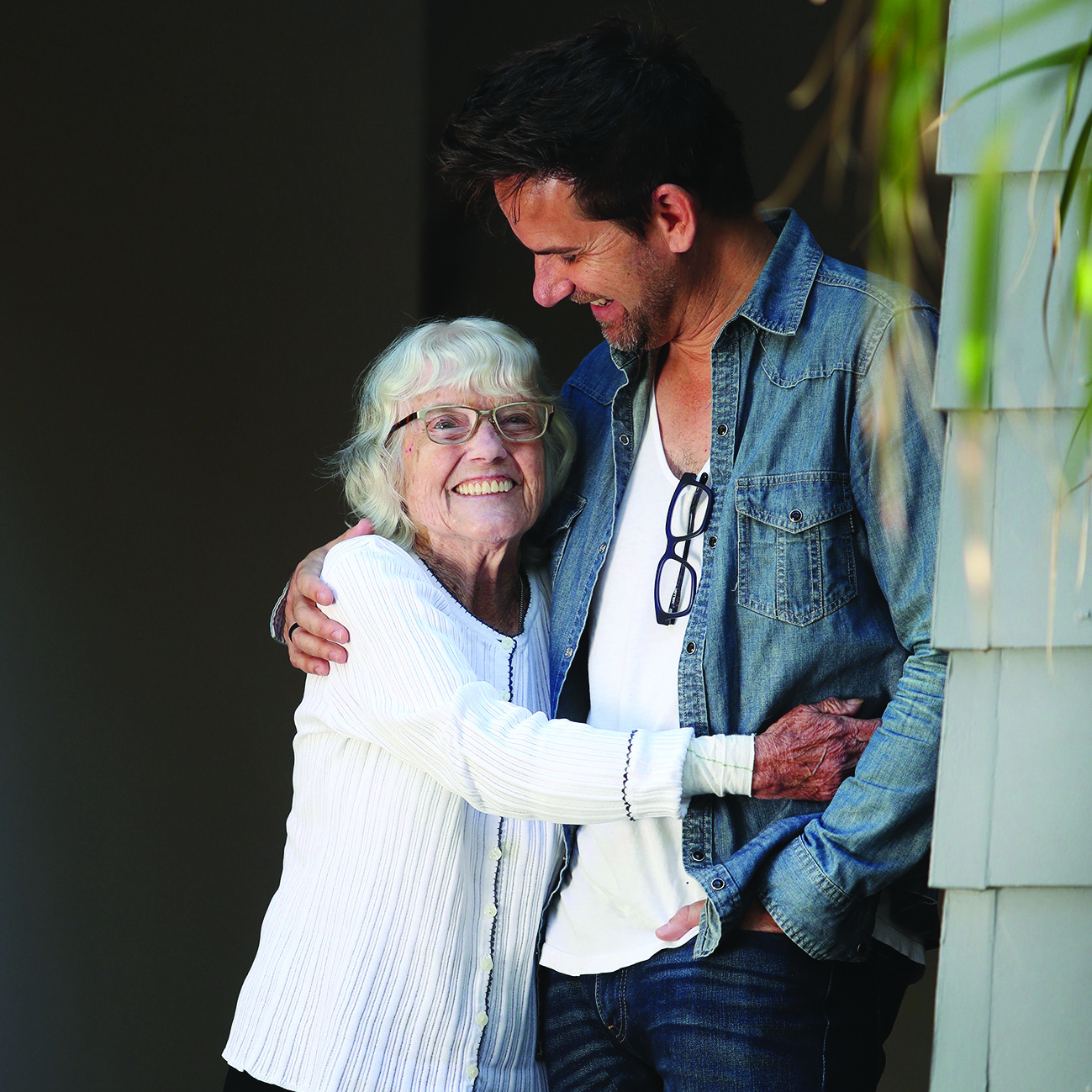
The grimness of this section of Everybody’s Oma’s penultimate act is compounded by the manner in which, as the family’s desperation and exhaustion become the narrative focus, Hendrika becomes a problem to be solved (the webcam images of her struggling to settle in her bed are particularly alienating and objectifying). At this point, the connection and community offered by social media that has previously been such an important part of the Oma story becomes a burden, as countless followers send direct messages asking after Hendrika’s health – a further obligation for a family that can no longer cope. However, just as they reach their lowest ebb, the almost magical discovery of a charming nursing home offering high-level respite care leads the narrative towards a feel-good resolution: Hendrika will have a large room with a balcony, all her favourite items from home and a gracious landscaped garden to sit in. The positivity kicks back in, with even subsequent COVID lockdowns becoming a source of family connection and a return to the performative modality of the public story that has been constructed around the documentary’s central figure.
This is a film where the private space of the family is harnessed to a community searching for connection. Indeed, the very existence of Everybody’s Oma is connected to the coming together of the community forged by van Genderen on social media. At the end of December 2020, the director announced an Indiegogo crowdfunding campaign for a documentary that would bring the ‘WHOLE story to the screen for a much bigger audience […] a story that’s heartwarming and real’;[10]‘Everybody’s Oma – the Documentary’, Indiegogo, <https://www.indiegogo.com/projects/everybody-s-oma-the-documentary/>, accessed 15 August 2022. donors’ contributions provided the funds to hire a cinematographer to film the family over the Christmas period and to create promotional materials. As the credits roll at the end of Everybody’s Oma, donors’ dedications to loved ones highlight the community that van Genderen has built through sharing his experience of life with his mother.
In examining his conscience about the intention and purpose of sharing videos of his ailing mother with a public audience, the director articulates three guiding questions: ‘Was it made with love? Was it educational? And what would my mum think of that when she was fully cognisant?’ The answer to the first two questions is never in doubt; but the third question is knitted into the very fabric of a documentary that is simultaneously intimate and very public. The ethics of representation are an ever-present conundrum for documentary filmmakers, and this conundrum is enacted in Everybody’s Oma, in which Hendrika’s warm smile becomes part of a shared story about the loss and loneliness so often experienced when caring for a loved one with dementia.
Endnotes
| 1 | John Polson, quoted in Garry Maddox, ‘Tropfest Tears to Flow with Love Letter to Dying Father’, The Sydney Morning Herald, 9 February 2011, <https://www.smh.com.au/entertainment/movies/tropfest-tears-to-flow-with-love-letter-to-dying-father-20110208-1aljs.html>, accessed 12 August 2022. |
|---|---|
| 2 | Brigid Delaney, ‘What Happened After a Grandma with Dementia Went Viral: “I Get the Trolling – I Didn’t Enjoy It”’, The Guardian, 10 August 2022, <https://www.theguardian.com/film/2022/aug/10/what-happened-after-a-grandma-with-dementia-went-viral-i-get-the-trolling-i-didnt-enjoy-it>, accessed 15 August 2022. |
| 3 | Jason van Genderen, ‘Director’s Statement’, Oma’s Applesauce Productions, Everybody’s Oma press kit, 2022, p. 5. |
| 4 | ‘Oma Shopping at Home During Isolation’, Facebook video, 27 April 2020, <https://www.facebook.com/omasapplesauce/videos/oma-shopping-at-home-during-isolation/237399264000653/>, accessed 15 August 2022. |
| 5 | Jason van Genderen, quoted in Amy Sinclair, ‘Coles Supermarket Social Media Sensation Hendrika “Oma” van Genderen Passes Away at Age 89’, 7news.com.au, updated 6 March 2022, <https://7news.com.au/lifestyle/shopping/coles-supermarket-social-media-sensation-hendrika-oma-van-genderen-passes-away-at-age-89-c-5915565>, accessed 15 August 2022. |
| 6 | ‘We Turned Oma’s House into an Aquarium for Mothers Day!’, Facebook video, 10 May 2020, <https://www.facebook.com/watch/?v=234827744512794>, accessed 16 August 2022. |
| 7 | ‘Oma at the Aquarium’, YouTube, 25 August 2020, <https://www.youtube.com/watch?v=m84ESPORyRE>, accessed 15 August 2022. |
| 8 | ‘Our First Aid Bag’, Facebook video, 12 September 2021, <https://www.facebook.com/omasapplesauce/videos/188826459897548>, accessed 16 August 2022. |
| 9 | ‘A Little Plate of Patience’, Facebook video, 27 February 2021, <https://www.facebook.com/omasapplesauce/videos/422218282407134>, accessed 16 August 2022. |
| 10 | ‘Everybody’s Oma – the Documentary’, Indiegogo, <https://www.indiegogo.com/projects/everybody-s-oma-the-documentary/>, accessed 15 August 2022. |
